“], “filter”: { “nextExceptions”: “img, blockquote, div”, “nextContainsExceptions”: “img, blockquote, a.btn, a.o-button”} }”>
Heading out the door? Learn this text on the brand new Exterior+ app accessible now on iOS gadgets for members!
>”,”identify”:”in-content-cta”,”kind”:”hyperlink”}}”>Obtain the app.
I’ve been instructing yoga for greater than a decade and training asana, or the bodily poses, since childhood, so I understand how the poses are purported to look.
However once I started providing on-demand courses and modifying my very own movies, what I noticed stunned me. Though I knew my alignment was being recorded and was attempting to set a correct instance for my college students, my on a regular basis postural patterns inevitably snuck into my poses.
I notice that yoga is about much more than exact shapes. However being stunned by the looks of my follow acquired me considering. May this expertise train me disrupt my default methods of holding myself on the mat? May it assist me set up extra consciousness and inhabit my physique with extra discernment?
The reply is sure. Following are the sudden methods your posture would possibly present up on the mat and what you are able to do to counter it. You would possibly even discover that you just’ll study to be extra aware of the way you inhabit your physique off the mat.
How Your Posture Exhibits Up in Your Yoga Follow
Chances are you’ll acknowledge a few of these tendencies in your personal follow. Once you’re paying consideration, you possibly can counter them. However when your thoughts drifts, it’s straightforward to slide proper again into previous habits as a result of it’s the trail of least resistance for each physique and thoughts. Stay conscious.
1. Leaning Your Head Ahead
The not-so-helpful behavior of slouching as you sit or leaning ahead whereas trying down at gadgets or screens is an exceptionally widespread inclination. Generally known as ahead head carriage, it means your chin juts ahead and down. And it exhibits up in your yoga follow.
Find out how to Repair It
Your head and neck positions in yoga are maybe essentially the most tough to note, not to mention counter, as a result of you possibly can’t see it for your self. Examine your self in a mirror or seize your self on video in Mountain Pose (Tadasana) or different standing and seated poses that require a impartial backbone, akin to Warrior 2 (Virabhadrasana) or Hero Pose (Virasana).
This behavior is much more more likely to drive its approach onto your mat if you’re in a much less acquainted orientation to gravity or have to recruit additional power or steadiness. That features…
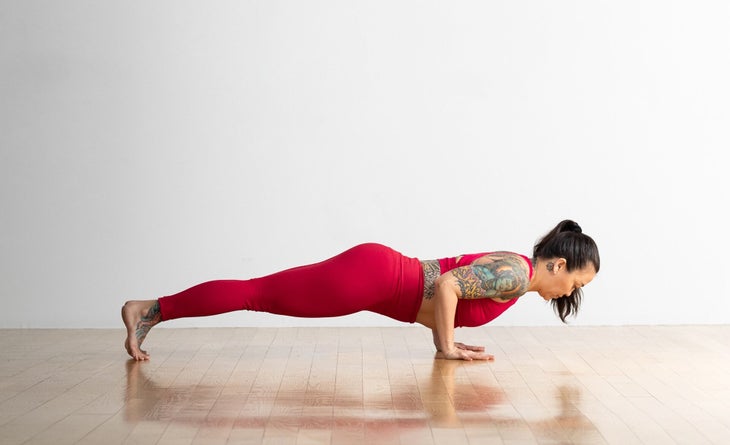
Holding Your self Horizontal
Your chin and head would possibly dip beneath the plumb line of the remainder of your physique in Plank, Low Plank (Chaturanga Dandasana), or Standing Half Ahead Elevate (Ardha Uttanasana). Think about reaching by way of the crown of your head somewhat than your chin.
Reclined Poses
Your chin would possibly inadvertently jut towards the ceiling in reclined poses akin to Bridge (Setu Bandha) and Savasana. That tilts your chin increased than your brow. Attempt sliding the again of your head away out of your shoulders to convey your chin and brow stage.
Headstand
A kink between the bottom of your cranium and the highest of your neck in Headstand (Salamba Sirsasana). From the skin, this appears to be like like the purpose of contact being extra towards your brow somewhat than the middle of your head. As a substitute, goal to really feel all 4 sides of your neck lengthen evenly.
2. Slouched Shoulders
A lot of how we spend our days requires that our arms attain in entrance of us or our shoulders slouch—driving, typing, carrying a heavy bag, attempting not to attract consideration to your top, even an unconscious need to guard your susceptible coronary heart. This causes the shoulders to lean barely ahead of the midline of the physique and turn out to be overly rounded. Because of this, we overtrain the chest muscular tissues to contract and undertrain the higher again muscular tissues.
Find out how to Repair It
You’ve probably been advised 1,000,000 occasions to sit down or get up straight. That message in all probability echoes by way of your ideas if you remind your self to face tall in Mountain or sit in Hero Pose. Nonetheless, rounded shoulders can sneak up on you in different poses as properly.
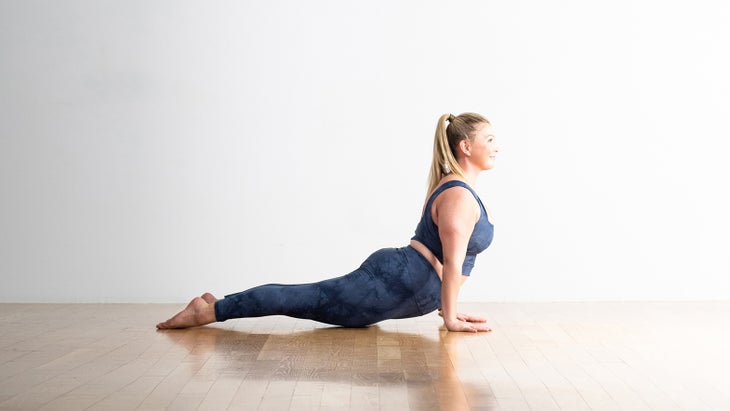
When You Take Your Arms Behind Your Physique
Chances are you’ll discover that your shoulders spherical towards your chest in Humble Warrior, Reverse Tabletop or Reverse Plank, and, to a lesser extent, Upward-Dealing with Canine (Urdhva Mukha Svanasana). Attempt pausing earlier than getting into the pose and squeezing your shoulder blades towards one another. Much more crucially, maintain that alignment as you progress into these poses.
Your Supporting Shoulder in Aspect Plank
Ever discover your backside shoulder protruding ahead towards your chest in Aspect Plank (Vasisthasana)? Recruiting the muscular tissues on the again of your shoulder assist create a extra impartial place. You are able to do this by imagining attempting to show your hand towards its little finger edge with out truly shifting it. Or, should you’re supporting your self in your forearm, somewhat than your palm, strive angling it towards the far high nook of your mat somewhat than maintaining your forearm parallel to the lengthy fringe of the mat.
Shoulders Dipping Towards the Ground in Chaturanga
Counter the ahead momentum of your shoulders by broadening your collarbones and lifting barely by way of the bottom of your sternum as should you have been initiating a backbend. It’s powerful to create a central shoulder place when gravity is working towards you, not to mention if you begin with rounded shoulders as you do in Plank, so it’s possible you’ll have to decrease your knees to the mat for some time in Chaturanga to provide the capability to be extra conscious in your alignment.
Reclined Poses
This appears to be like like a niche between your shoulders and your mat in reclined poses akin to Savasana or within the trailing shoulder of a supine twist. Attempt adjusting your arm place to assist your shoulders launch towards the mat in these poses.
3. Hyperlordosis
Lordosis is an anatomical time period used to explain the pure backbend that exists in your low again and neck. Hyperlordosis merely refers to a deeper backbend than regular and normally describes the curve of the low again. It could possibly be because of a easy behavior of stress-free your stomach or might stem from modifications to your biomechanics like carrying excessive heels or carrying unaccustomed weight in your stomach, akin to throughout being pregnant.
In a yoga context, the time period is typically used as shorthand for a bigger sample, together with the decrease entrance ribs flaring up and out and the pelvis tipping ahead towards the fronts of the thighs.
Find out how to Repair It
A number of the commonest cues for Mountain and neutral-spine standing poses akin to Warrior 2 are geared toward countering this postural sample. These embrace “knit your low ribs,” “raise your decrease stomach,” or “lengthen your sacrum.” Hear them typically sufficient and also you’ll begin to regulate your place accordingly.
Nonetheless, when widespread instructing cues counsel the other tendency from yours, they will overemphasize your habits as an alternative of counter them.
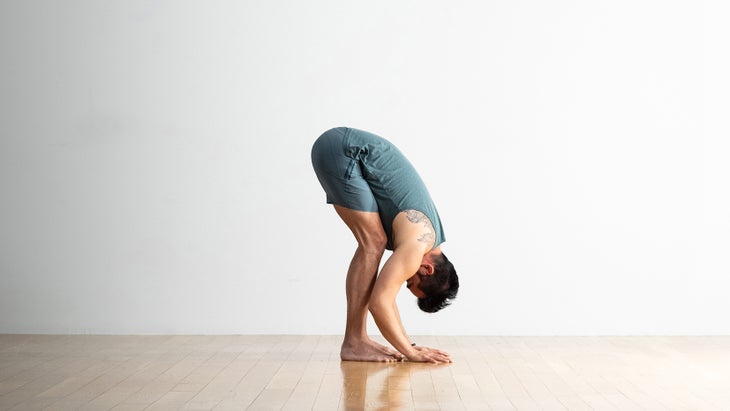
Transferring Into Standing and Seated Ahead Bends
Consider the transition from Mountain to Standing Ahead Bend (Uttanasana) or from Workers Pose (Dandasana) to the Seated Ahead Bend (Paschimottanasana), your trainer would possibly cue a “swan dive” or to “lead along with your coronary heart” or to “ship your sit bones again” to encourage a hinge on the hips somewhat than a rounding in your backbone. However if you already embody this sample as your default, it’s all too straightforward to overdo it, dropping the assist that robust legs or a subtly engaged stomach can present.
In standing ahead bends, strive maintaining your weight midfoot, with a slight bend in your knees, and in seated ahead bends goal to remain grounded by way of your sit bones. Then in each variations maintain your collarbones broad, however think about gently drawing your low entrance ribs towards one another and towards your pubic bone to keep up refined stomach engagement.
Backbends
In Camel (Ustrasana) or Upward-Dealing with Canine, it’s possible you’ll expertise stress or compression in your low again as an alternative of a balanced sensation of shortening alongside the again physique and lengthening alongside the entrance physique. Once you begin with an already exaggerated arch in your low again, it doesn’t take lengthy to succeed in your restrict in backbends.
Earlier than shifting into again bending poses, intentionally lengthen your sacrum and raise your decrease stomach to convey your pelvis to a extra impartial place and thereby lower the curve in the back of your waist. This will help distribute the strain of the backbend between the fronts of your hips and your torso, as an alternative of forcing all of it into your lumbar backbone.
Seated Breathwork or Meditation
Educating cues meant to counter slouching—akin to “open your coronary heart,” “raise your sternum,” “soften your stomach,” and even “breathe deep”—might be counter-productive for these scuffling with the behavior of hyperlordosis.
As a substitute, construct from a impartial pelvic place, during which the back and front of your pelvis are roughly stage or parallel, after which middle your ribcage instantly above. Think about your again ribs and kidney area are as spacious as your stomach and chest.
4. “Locked” Knees
In yoga, we speak about “locked” or hyperextended knees when the legs transfer past a straight 180 diploma line to a slight banana or backbend form. Completely different college students have this capability to a distinct extent. In on a regular basis life, it’s not a trigger for concern; it’s merely the physique’s approach of conserving muscle effort after we stand upright. However if you load all your physique weight onto one leg, or transfer between standing poses, it’d pay to recruit the muscular tissues round your knees to assist your joints extra mindfully.
Find out how to Repair It
Locked knees are more likely to seem in Mountain, particularly as lecturers typically take time there to cue alignment from the muse up. Nonetheless, recurring knee hyperextension can sneak up on you when your consideration is elsewhere, akin to if you’re shifting between poses, preventing to keep up or regain your steadiness, or if you enhance the load or load on one leg.
Transitioning from Standing to Ahead Bend
In your effort to swan dive in ahead folds (as described above), you would possibly lean again into your heels and lock your knees to make use of the backward shift of your hips as a counterweight for the ahead motion of your higher physique. In these transitions, as an alternative goal to anchor your weight mid-foot by evenly distributing the load between the balls of your toes and the heels. Additionally, take a slight bend in your knees to make use of your leg muscular tissues as an alternative of momentum.
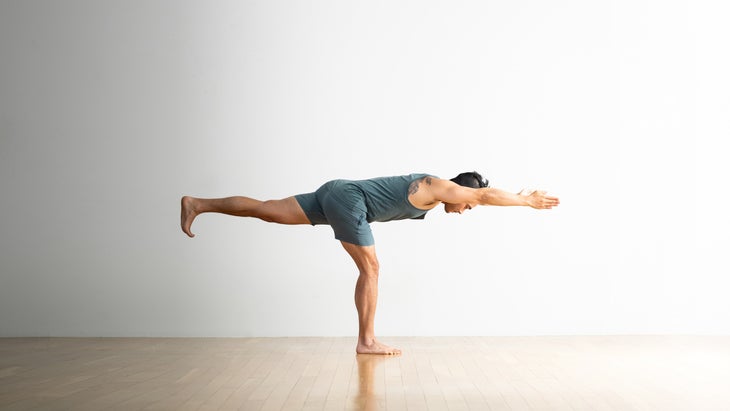
Standing Stability Poses
This additionally exhibits up in Half Moon (Ardha Chandrasana) and Warrior 3 (Virabhadrasana III). When it’s taking all of your effort to remain on one foot, you’re much more more likely to depend on acquainted habits to scale back bodily and psychological effort. And in these poses, the stacked bones of a passively straight leg can present the phantasm of stability that the slightest wobble in your foot can dissolve. As soon as once more, goal to maintain your weight midfoot and your standing knee barely bent. A bent standing knee feels much less stable and secure, however it’s going to drive your leg and hip muscular tissues to interact to offer the construction you are feeling you lack.
Entrance Leg in Triangle (Trikonasana)
Your middle of gravity shifts ahead towards your entrance knee in Triangle Pose. The well-intentioned cue to “raise your kneecap” to interact the quadriceps on the highest of your thigh can truly be unhelpful right here because it has the potential to deepen knee hyperextension.
By all means, contract your quads, however on the identical time take a slight bend in your entrance knee and press into the ball of your entrance foot as firmly as your heel. Think about attempting to tug your entrance foot towards your again foot to immediate your hamstrings, internal thighs (adductors), and even calves to interact and supply further assist in your knee.
5. “Banana Foot”
What’s It?
Many yoga poses stretch your outer ankle. Take into consideration the place of your again foot of Warrior 1 (Virabhadrasana I), Warrior 2, Triangle, Prolonged Aspect Angle (Utthita Parsvakonasana), and so forth. Every of those successfully angles the only of your foot towards the midline of your physique.
You may need heard this place known as ankle inversion or foot supination. The other place of ankle eversion or foot pronation, during which the only of your foot turns away from the midline of the physique, is definitely a extra widespread postural behavior, however is so not often required in yoga that we miss alternatives to create it when maybe we should always.
Find out how to Repair It
You’ve in all probability been cautioned towards banana foot within the again leg of Pigeon Pose (Eka Pada Rajakapotasana) when lecturers warning towards letting your foot roll off to the facet. Creating extra engagement within the outer ankle can enhance your expertise of a pose. Pay attention to “banana foot” in:
Straightforward Pose (Sukhasana)
Banana foot would present up right here as your outer ankles curving outward to relaxation on the mat if you’re sitting cross-legged. There’s no hurt in experiencing “banana foot” on this place, however it’s a great place to start out cultivating consciousness of your tendencies since you possibly can simply see your toes and ankles and really feel the contact between them and the mat.
To counteract banana foot, visualize a zipper working out of your outer mid foot to your outer ankle bone and zip it as much as raise your outer ankles away from the mat and really feel your outer ankles and calves contract. Do that instantly in Aspect Plank and also you’ll in all probability fail as there’s simply an excessive amount of different stuff occurring. However follow it or train it right here so the engagement turns into acquainted and also you or your college students can apply it later
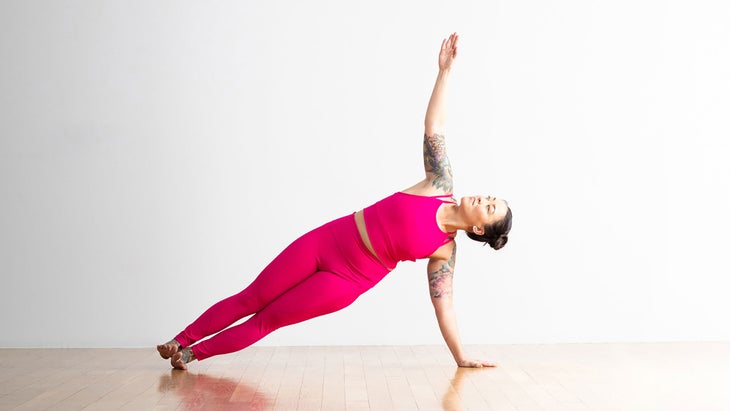
Aspect Plank (Vasisthasana)
The power and stability required by Aspect Plank might be sufficient of a problem such that your consideration is spent lengthy earlier than it reaches your toes. However the passive outer ankle of “banana foot” is a missed alternative for muscle engagement. Because the outer fringe of your backside foot and your backside hand are your foundations on this pose, the extra secure they’re, the higher. Attempt utilizing the zipper analogy once more to attract your outer ankle bone away from the mat and interact your outer calf, making a stronger and extra lively base.
Standing Stability Poses
The problem of standing on one foot tends to convey out our postural habits. This explicit behavior is exacerbated by well-intentioned cues to “raise the arch of your foot.” Whereas it is very important recruit your foot and ankle muscular tissues, focusing solely in your internal foot can ship an excessive amount of of your weight to your outer foot. As a substitute, think about balancing your weight within the junction between your two arches—the one between the ball of your standing foot and your heel, and the second between your internal mid-foot and your outer mid-foot—to create a extra central basis.
Your asana follow doesn’t have to be a campaign for some elusive concept of good posture. However what it will possibly turn out to be is a glimpse at your habits, particularly the place they may would possibly sneak up on you. That permits you a chance for discernment as as to whether you select to allow them to to form your conduct or not.
“], “filter”: { “nextExceptions”: “img, blockquote, div”, “nextContainsExceptions”: “img, blockquote, a.btn, a.o-button”} }”>
Heading out the door? Learn this text on the brand new Exterior+ app accessible now on iOS gadgets for members!
>”,”identify”:”in-content-cta”,”kind”:”hyperlink”}}”>Obtain the app.
I’ve been instructing yoga for greater than a decade and training asana, or the bodily poses, since childhood, so I understand how the poses are purported to look.
However once I started providing on-demand courses and modifying my very own movies, what I noticed stunned me. Though I knew my alignment was being recorded and was attempting to set a correct instance for my college students, my on a regular basis postural patterns inevitably snuck into my poses.
I notice that yoga is about much more than exact shapes. However being stunned by the looks of my follow acquired me considering. May this expertise train me disrupt my default methods of holding myself on the mat? May it assist me set up extra consciousness and inhabit my physique with extra discernment?
The reply is sure. Following are the sudden methods your posture would possibly present up on the mat and what you are able to do to counter it. You would possibly even discover that you just’ll study to be extra aware of the way you inhabit your physique off the mat.
How Your Posture Exhibits Up in Your Yoga Follow
Chances are you’ll acknowledge a few of these tendencies in your personal follow. Once you’re paying consideration, you possibly can counter them. However when your thoughts drifts, it’s straightforward to slide proper again into previous habits as a result of it’s the trail of least resistance for each physique and thoughts. Stay conscious.
1. Leaning Your Head Ahead
The not-so-helpful behavior of slouching as you sit or leaning ahead whereas trying down at gadgets or screens is an exceptionally widespread inclination. Generally known as ahead head carriage, it means your chin juts ahead and down. And it exhibits up in your yoga follow.
Find out how to Repair It
Your head and neck positions in yoga are maybe essentially the most tough to note, not to mention counter, as a result of you possibly can’t see it for your self. Examine your self in a mirror or seize your self on video in Mountain Pose (Tadasana) or different standing and seated poses that require a impartial backbone, akin to Warrior 2 (Virabhadrasana) or Hero Pose (Virasana).
This behavior is much more more likely to drive its approach onto your mat if you’re in a much less acquainted orientation to gravity or have to recruit additional power or steadiness. That features…

Holding Your self Horizontal
Your chin and head would possibly dip beneath the plumb line of the remainder of your physique in Plank, Low Plank (Chaturanga Dandasana), or Standing Half Ahead Elevate (Ardha Uttanasana). Think about reaching by way of the crown of your head somewhat than your chin.
Reclined Poses
Your chin would possibly inadvertently jut towards the ceiling in reclined poses akin to Bridge (Setu Bandha) and Savasana. That tilts your chin increased than your brow. Attempt sliding the again of your head away out of your shoulders to convey your chin and brow stage.
Headstand
A kink between the bottom of your cranium and the highest of your neck in Headstand (Salamba Sirsasana). From the skin, this appears to be like like the purpose of contact being extra towards your brow somewhat than the middle of your head. As a substitute, goal to really feel all 4 sides of your neck lengthen evenly.
2. Slouched Shoulders
A lot of how we spend our days requires that our arms attain in entrance of us or our shoulders slouch—driving, typing, carrying a heavy bag, attempting not to attract consideration to your top, even an unconscious need to guard your susceptible coronary heart. This causes the shoulders to lean barely ahead of the midline of the physique and turn out to be overly rounded. Because of this, we overtrain the chest muscular tissues to contract and undertrain the higher again muscular tissues.
Find out how to Repair It
You’ve probably been advised 1,000,000 occasions to sit down or get up straight. That message in all probability echoes by way of your ideas if you remind your self to face tall in Mountain or sit in Hero Pose. Nonetheless, rounded shoulders can sneak up on you in different poses as properly.

When You Take Your Arms Behind Your Physique
Chances are you’ll discover that your shoulders spherical towards your chest in Humble Warrior, Reverse Tabletop or Reverse Plank, and, to a lesser extent, Upward-Dealing with Canine (Urdhva Mukha Svanasana). Attempt pausing earlier than getting into the pose and squeezing your shoulder blades towards one another. Much more crucially, maintain that alignment as you progress into these poses.
Your Supporting Shoulder in Aspect Plank
Ever discover your backside shoulder protruding ahead towards your chest in Aspect Plank (Vasisthasana)? Recruiting the muscular tissues on the again of your shoulder assist create a extra impartial place. You are able to do this by imagining attempting to show your hand towards its little finger edge with out truly shifting it. Or, should you’re supporting your self in your forearm, somewhat than your palm, strive angling it towards the far high nook of your mat somewhat than maintaining your forearm parallel to the lengthy fringe of the mat.
Shoulders Dipping Towards the Ground in Chaturanga
Counter the ahead momentum of your shoulders by broadening your collarbones and lifting barely by way of the bottom of your sternum as should you have been initiating a backbend. It’s powerful to create a central shoulder place when gravity is working towards you, not to mention if you begin with rounded shoulders as you do in Plank, so it’s possible you’ll have to decrease your knees to the mat for some time in Chaturanga to provide the capability to be extra conscious in your alignment.
Reclined Poses
This appears to be like like a niche between your shoulders and your mat in reclined poses akin to Savasana or within the trailing shoulder of a supine twist. Attempt adjusting your arm place to assist your shoulders launch towards the mat in these poses.
3. Hyperlordosis
Lordosis is an anatomical time period used to explain the pure backbend that exists in your low again and neck. Hyperlordosis merely refers to a deeper backbend than regular and normally describes the curve of the low again. It could possibly be because of a easy behavior of stress-free your stomach or might stem from modifications to your biomechanics like carrying excessive heels or carrying unaccustomed weight in your stomach, akin to throughout being pregnant.
In a yoga context, the time period is typically used as shorthand for a bigger sample, together with the decrease entrance ribs flaring up and out and the pelvis tipping ahead towards the fronts of the thighs.
Find out how to Repair It
A number of the commonest cues for Mountain and neutral-spine standing poses akin to Warrior 2 are geared toward countering this postural sample. These embrace “knit your low ribs,” “raise your decrease stomach,” or “lengthen your sacrum.” Hear them typically sufficient and also you’ll begin to regulate your place accordingly.
Nonetheless, when widespread instructing cues counsel the other tendency from yours, they will overemphasize your habits as an alternative of counter them.

Transferring Into Standing and Seated Ahead Bends
Consider the transition from Mountain to Standing Ahead Bend (Uttanasana) or from Workers Pose (Dandasana) to the Seated Ahead Bend (Paschimottanasana), your trainer would possibly cue a “swan dive” or to “lead along with your coronary heart” or to “ship your sit bones again” to encourage a hinge on the hips somewhat than a rounding in your backbone. However if you already embody this sample as your default, it’s all too straightforward to overdo it, dropping the assist that robust legs or a subtly engaged stomach can present.
In standing ahead bends, strive maintaining your weight midfoot, with a slight bend in your knees, and in seated ahead bends goal to remain grounded by way of your sit bones. Then in each variations maintain your collarbones broad, however think about gently drawing your low entrance ribs towards one another and towards your pubic bone to keep up refined stomach engagement.
Backbends
In Camel (Ustrasana) or Upward-Dealing with Canine, it’s possible you’ll expertise stress or compression in your low again as an alternative of a balanced sensation of shortening alongside the again physique and lengthening alongside the entrance physique. Once you begin with an already exaggerated arch in your low again, it doesn’t take lengthy to succeed in your restrict in backbends.
Earlier than shifting into again bending poses, intentionally lengthen your sacrum and raise your decrease stomach to convey your pelvis to a extra impartial place and thereby lower the curve in the back of your waist. This will help distribute the strain of the backbend between the fronts of your hips and your torso, as an alternative of forcing all of it into your lumbar backbone.
Seated Breathwork or Meditation
Educating cues meant to counter slouching—akin to “open your coronary heart,” “raise your sternum,” “soften your stomach,” and even “breathe deep”—might be counter-productive for these scuffling with the behavior of hyperlordosis.
As a substitute, construct from a impartial pelvic place, during which the back and front of your pelvis are roughly stage or parallel, after which middle your ribcage instantly above. Think about your again ribs and kidney area are as spacious as your stomach and chest.
4. “Locked” Knees
In yoga, we speak about “locked” or hyperextended knees when the legs transfer past a straight 180 diploma line to a slight banana or backbend form. Completely different college students have this capability to a distinct extent. In on a regular basis life, it’s not a trigger for concern; it’s merely the physique’s approach of conserving muscle effort after we stand upright. However if you load all your physique weight onto one leg, or transfer between standing poses, it’d pay to recruit the muscular tissues round your knees to assist your joints extra mindfully.
Find out how to Repair It
Locked knees are more likely to seem in Mountain, particularly as lecturers typically take time there to cue alignment from the muse up. Nonetheless, recurring knee hyperextension can sneak up on you when your consideration is elsewhere, akin to if you’re shifting between poses, preventing to keep up or regain your steadiness, or if you enhance the load or load on one leg.
Transitioning from Standing to Ahead Bend
In your effort to swan dive in ahead folds (as described above), you would possibly lean again into your heels and lock your knees to make use of the backward shift of your hips as a counterweight for the ahead motion of your higher physique. In these transitions, as an alternative goal to anchor your weight mid-foot by evenly distributing the load between the balls of your toes and the heels. Additionally, take a slight bend in your knees to make use of your leg muscular tissues as an alternative of momentum.

Standing Stability Poses
This additionally exhibits up in Half Moon (Ardha Chandrasana) and Warrior 3 (Virabhadrasana III). When it’s taking all of your effort to remain on one foot, you’re much more more likely to depend on acquainted habits to scale back bodily and psychological effort. And in these poses, the stacked bones of a passively straight leg can present the phantasm of stability that the slightest wobble in your foot can dissolve. As soon as once more, goal to maintain your weight midfoot and your standing knee barely bent. A bent standing knee feels much less stable and secure, however it’s going to drive your leg and hip muscular tissues to interact to offer the construction you are feeling you lack.
Entrance Leg in Triangle (Trikonasana)
Your middle of gravity shifts ahead towards your entrance knee in Triangle Pose. The well-intentioned cue to “raise your kneecap” to interact the quadriceps on the highest of your thigh can truly be unhelpful right here because it has the potential to deepen knee hyperextension.
By all means, contract your quads, however on the identical time take a slight bend in your entrance knee and press into the ball of your entrance foot as firmly as your heel. Think about attempting to tug your entrance foot towards your again foot to immediate your hamstrings, internal thighs (adductors), and even calves to interact and supply further assist in your knee.
5. “Banana Foot”
What’s It?
Many yoga poses stretch your outer ankle. Take into consideration the place of your again foot of Warrior 1 (Virabhadrasana I), Warrior 2, Triangle, Prolonged Aspect Angle (Utthita Parsvakonasana), and so forth. Every of those successfully angles the only of your foot towards the midline of your physique.
You may need heard this place known as ankle inversion or foot supination. The other place of ankle eversion or foot pronation, during which the only of your foot turns away from the midline of the physique, is definitely a extra widespread postural behavior, however is so not often required in yoga that we miss alternatives to create it when maybe we should always.
Find out how to Repair It
You’ve in all probability been cautioned towards banana foot within the again leg of Pigeon Pose (Eka Pada Rajakapotasana) when lecturers warning towards letting your foot roll off to the facet. Creating extra engagement within the outer ankle can enhance your expertise of a pose. Pay attention to “banana foot” in:
Straightforward Pose (Sukhasana)
Banana foot would present up right here as your outer ankles curving outward to relaxation on the mat if you’re sitting cross-legged. There’s no hurt in experiencing “banana foot” on this place, however it’s a great place to start out cultivating consciousness of your tendencies since you possibly can simply see your toes and ankles and really feel the contact between them and the mat.
To counteract banana foot, visualize a zipper working out of your outer mid foot to your outer ankle bone and zip it as much as raise your outer ankles away from the mat and really feel your outer ankles and calves contract. Do that instantly in Aspect Plank and also you’ll in all probability fail as there’s simply an excessive amount of different stuff occurring. However follow it or train it right here so the engagement turns into acquainted and also you or your college students can apply it later

Aspect Plank (Vasisthasana)
The power and stability required by Aspect Plank might be sufficient of a problem such that your consideration is spent lengthy earlier than it reaches your toes. However the passive outer ankle of “banana foot” is a missed alternative for muscle engagement. Because the outer fringe of your backside foot and your backside hand are your foundations on this pose, the extra secure they’re, the higher. Attempt utilizing the zipper analogy once more to attract your outer ankle bone away from the mat and interact your outer calf, making a stronger and extra lively base.
Standing Stability Poses
The problem of standing on one foot tends to convey out our postural habits. This explicit behavior is exacerbated by well-intentioned cues to “raise the arch of your foot.” Whereas it is very important recruit your foot and ankle muscular tissues, focusing solely in your internal foot can ship an excessive amount of of your weight to your outer foot. As a substitute, think about balancing your weight within the junction between your two arches—the one between the ball of your standing foot and your heel, and the second between your internal mid-foot and your outer mid-foot—to create a extra central basis.
Your asana follow doesn’t have to be a campaign for some elusive concept of good posture. However what it will possibly turn out to be is a glimpse at your habits, particularly the place they may would possibly sneak up on you. That permits you a chance for discernment as as to whether you select to allow them to to form your conduct or not.












